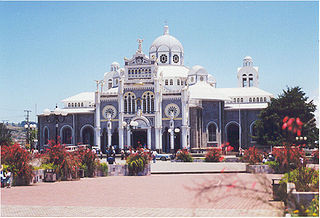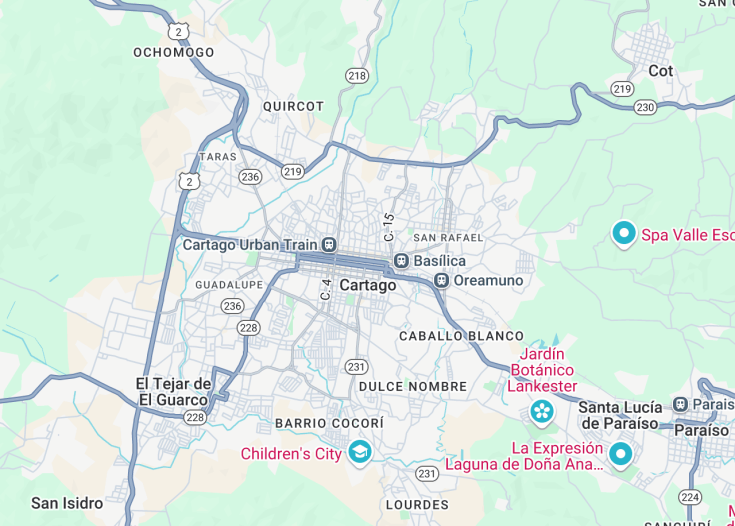Cartago, once the capital of Costa Rica, is a city steeped in history and surrounded by lush, verdant landscapes. Nestled in the Central Valley, it is famed for its rich colonial heritage, exemplified by the ruins of Santiago Apóstol Church and the iconic Basílica de Nuestra Señora de los Ángeles. The city serves as a gateway to Irazú Volcano National Park, offering paths to the crater’s eerie lunar-like landscape. Cartago provides an enchanting mix of historical depth and natural beauty, making it a compelling destination for travelers seeking a profound cultural experience.
Before visiting Cartago, check the local weather as the climate can be quite temperate. Packing layers will ensure comfort while exploring both the historic sites and the cooler, higher altitudes of nearby national parks.
Enhance your Cartago visit by timing it with a local festival, like the annual pilgrimage in August to the Basílica de Nuestra Señora de los Ángeles, which blends cultural heritage with local festivities.
Top things to do & see in Cartago
Select the following sights and activities to discover best tickets and tours available in Cartago.
Cartago: The Historical Heart of Costa Rica
| Country | Costa Rica |
| Time in Cartago | GMT-6 |
| Language spoken | Spanish |
| Population | 156,600 (source: Instituto Nacional de Estadística y Censos, 2023) |
| Currency | Costa Rican Colón (CRC ₡) |
| Airports |
|
Cartago, the ancient capital of Costa Rica, is drenched in history and rich cultural heritage. Found in the central part of the country, it is flanked by Cartago Volcano to the east and the lush Central Valley to the west. As one of the oldest settlements in Costa Rica, established in 1563, Cartago has been at the forefront of Costa Rican history, witnessing significant national events like the Spanish colonial era and the independence movement. Its streets and buildings reflect this deep historical significance, featuring colonial architecture and ancient ruins that attract scholars and tourists alike.
The city is also famous for the Basilica of Our Lady of the Angels, a major pilgrimage site where thousands gather each year on August 2nd to pay homage, believed to have miraculous healing powers. Cartago’s cool highland climate, combined with surrounding coffee plantations and volcanic landscapes, offers a refreshing escape from the tropical heat elsewhere in the country. It presents a blend of breathtaking scenery, historical depth, and cultural richness, making it an essential stop for anyone traveling through Central America. Modern Cartago retains its charm through vibrant local festivals, educational institutions, and a focus on preserving its unique heritage and environment.
Where is Cartago?
Located in the central region of Costa Rica, approximately at the heart of the country’s mountainous spine.
Distances:
| Route | Distance by Car | Time by Car |
|---|---|---|
| San José to Cartago | 15 miles (24 km) | 40 minutes |
| Limon to Cartago | 118 miles (190 km) | 3 hours 20 minutes |
| Heredia to Cartago | 27 miles (43 km) | 1 hour 15 minutes |
What is Cartago famous for?
Cartago is renowned for its rich colonial history, being Costa Rica’s original capital and the host of the venerated Basilica of Our Lady of the Angels. It also flaunts striking natural landscapes and significant archeological sites.
History
Pre-Columbian and Colonial Era (before 1563)
Cartago, nestled in the central valley of Costa Rica, was originally inhabited by the Huetar people, a sophisticated indigenous group well-versed in agriculture and pottery. The region’s fertile lands and strategic location made it a significant settlement area for these early inhabitants. In 1563, the Spanish conquistador Juan Vázquez de Coronado established the city, making it one of the first Spanish settlements in the Americas. Cartago became the capital of the colony, playing a pivotal role in the administrative and ecclesiastical affairs of the region.
Colonial Capital and Independence (1563-1821)
During the colonial period, Cartago remained the capital and was the heart of Costa Rica’s religious, political, and social life. Notable architectural projects, such as the construction of various churches and the central market, marked this era. However, frequent earthquakes presented significant challenges. The city was often at the center of struggles for power among colonial factions, which shaped its development. In 1821, when Costa Rica declared its independence from Spain, Cartago played a central role in the political processes that followed.
Post-Independence Era (1821-20th century)
After independence, Cartago’s prominence as a political center declined when the capital was moved to San José in 1823 due to ongoing conflicts and natural disasters. Despite this, the city remained an important cultural and agricultural hub. The 19th and early 20th centuries saw the growth of coffee cultivation, which significantly influenced the region’s economy and society. The city also endured several devastating earthquakes, most notably in 1841 and 1910, each prompting periods of rebuilding and architectural evolution.
Modern Day (20th century to Present)
In the 20th century, Cartago transitioned into a modern urban area, diversifying its economy beyond agriculture, particularly into services and education. Today, it is known for its historical sites, cultural heritage, and as a center of education with notable institutions such as the Technological Institute of Costa Rica. The preservation of its rich historical architecture alongside modern developments encapsulates the city’s resilience and adaptability through the ages.
Visit Cartago
What to see and do in Cartago, Costa Rica
When in Cartago, visitors can immerse themselves in a rich tapestry of history and nature. Notable attractions include the Basilica of Our Lady of the Angels, a stunning example of Byzantine and colonial architecture, housing the revered statue of the Black Madonna. Nature enthusiasts will appreciate the Lankester Botanical Gardens, featuring an extensive collection of orchids and other exotic plant species. The nearby Irazú Volcano National Park offers breathtaking views and striking lunar landscapes.
- Basilica of Our Lady of the Angels
- Lankester Botanical Gardens
- Irazú Volcano National Park
Festivals and Celebrations in Cartago
Cartago is vibrant with cultural festivities, most notably the annual pilgrimage to the Basilica of Our Lady of the Angels on August 2nd. This event draws thousands of devotees from across the country, paying homage in a centuries-old tradition. Another significant event is the Holy Week processions, a deeply spiritual experience displaying the city’s rich religious traditions and historical pageantry.
Best time to visit Cartago
The best time to visit Cartago is during the dry season, from mid-December to April. This period offers clear skies and comfortable temperatures, ideal for exploring the city’s outdoor attractions and historical sites.
Is Cartago worth visiting?
Cartago certainly warrants a visit for those interested in exploring the real Costa Rica. Its blend of historical significance, architectural gems, and natural beauty provides a unique glimpse into the country’s past and present. Whether you are drawn to religious history, botany, or volcanic landscapes, Cartago offers a compelling itinerary for all.










